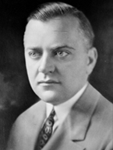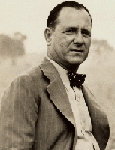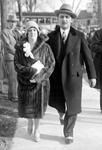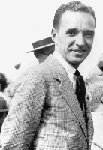
Introduction
The Utilitarian Vision of Henry Ford
General Motors Style Overtakes Ford Efficiency
The Changing American Character
The Struggle for Styling in the Early Industry
The Depression Era Battle for Streamlining
The Triumph of Stylists in the 1950s
Contradictions of Fantastic Styling and the Stylists' Fall From Grace
Stylists Fight Back with "AERO"
Postindustrial Lifestyle Cars & The New Balance of Power Between Engineers and Designers
Complete Text Printable View
Tough Guys and Pretty Boys:
The Cultural Antagonisms of Engineering and Aesthetics in Automotive History
The Struggle For Styling in the Early Industry
The battle between beauty and utility in the automobile industry and American society was far from over, however, in 1927. Although GM's Sloan had discovered a strategy that resonated with cultural changes in America, he had yet to find the means to implement it. How do you routinely mass produce variety, novelty, and distinction? In 1927 Sloan did not know exactly how this could be done, but he believed he knew who could do it. His name was Harley Earl. Earl was the diametrical opposite of the no-nonsense, utility-obsessed engineers like Henry Ford who created and ran the early automobile industry. He came from Hollywood, the capital of consumer dreams, where he grew up in his father's coachbuilding shop building custom car bodies for the movies and their stars. He thus learned early on to think of cars as entertainment, not utilitarian vehicles. “People like something new and exciting in an automobile as well as in a Broadway show,” he stated. “They like visual entertainment and that’s what we stylists give them.” His special bodies for a California Cadillac dealer brought him to the attention of GM's Cadillac division head, Larry Fisher. He was planning to introduce in 1927 an inexpensive, mass-produced Cadillac called the La Salle. He hired Earl to design it, specifying that he bring the look of luxury to this cheap Cadillac. The 1927 La Salle was an instant success, hailed by critics as one of the most beautiful cars ever built. Sloan was so impressed with Earl’s work that in June of 1927 he hired him to establish the first styling department of a major mass-production auto firm, General Motors’ Art and Color Section. Earl did not like this initial name given his department. He complained that it was a "sissy name," and herein lay one of his major challenges.
Earl faced an uphill battle to establish GM’s new emphasis on style over engineering, and both he and Sloan knew it. Up to this point, the American automobile industry had been built and controlled by the "tough guys," the hard-nosed engineers and production men who thought of the car as an instrument of transportation, not an object of entertainment. The task of car-body design that Earl proposed to take over was controlled by a specialized group of these tough guys, the body engineers. Bill Mitchell, one of Earl’s stylists at GM, described these men as looking like house detectives, "wearing their hats all the time, suspenders and belts, button shoes, with pencils in their pockets and their taste in their mouths." They were foul-mouthed, hard-drinking, fist-fighting macho men, who believed that beauty belonged in the parlor and questioned the masculinity of any man who wanted to put it on a car. Earl, by contrast, was a perennially tanned Californian, accustomed to dressing in bronze suits, purple shirts, and suede shoes. No wonder the body engineers resentfully called the stylists “pretty-picture boys,” “fairies,” and “pantywaists.”
There was definitely a gender dimension to this conflict, one that originated in the division of labor between men and women in early industrial society. At this time, earning a living was physically separated from the home, and became the exclusive province of men. All the nonutilitarian attributes of life--art, beauty, culture--were left behind in the home for women to tend to. So any concern for beauty became defined as feminine and hence unwelcome in the manly, efficiency-obsessed world of work. This gendered division of utility and beauty seems to have been one of the main sources of the infamous conflict between Henry Ford and his only son, Edsel. For the father of mass production and down-to-earth automotive utility, not only was history “bunk” but so were art and beauty. His son Edsel, by contrast, grew up to be a sophisticated and stylish man with artistic tastes and a great interest in auto aesthetics. In 1922 he convinced his father to buy the luxury-car firm Lincoln and quickly became involved in body design there. And it was Edsel who also convinced Henry to finally replace the dowdy Model T with the stylish Model A, which he helped to design by bringing a touch of his Lincolns to his dad’s Ford. But although Henry tolerated Edsel’s aesthetic tinkerings at Lincoln, he believed his son to be insufficiently manly for the rough world of mass-produced automobiles, and he resisted Edsel's efforts to introduce more style into Ford cars. Although he eventually made Edsel president of Ford Motor Company, Henry often delegated real power to rough, fist-fighting men like Charles Sorensen and Harry Bennett. Sorensen, who ran Ford’s River Rouge plant for years, was known to show his disapproval for a worker’s performance by tipping over his bench or crashing a stool over it. As head of Ford’s infamous Service Department, Bennett and his fellow toughs launched a reign of terror against workers’ efforts to unionize Ford that culminated in the 1937 Battle of the Overpass, in which they attacked union organizers, killing one.
Alfred Sloan and Harley Earl understood, however, that the gendered division between beauty and utility was breaking down in the 1920s. Men subjected to the savage utility and efficiency of mass production were looking to the home and its nonutilitarian consumer goods for compensation. Thus, beauty could no longer be confined to the feminine parlor but spread to masculine consumer machines like the automobile. But in order to break the feminine stigma of style and produce cars that hid the ugly world of work, pioneers like Harley Earl had to fight long and hard with the defenders of the old order of automotive utility. The battles he fought with the body engineers were monumental, especially those with the Fisher brothers, who controlled GM’s bodybuilding division. Bill Mitchell, an early GM stylist, recalled that the differences in automotive philosophy between the stylists and engineers were symbolized by the contrast of personal styles between Earl and the Fishers: “The Fisher brothers were small,... they wore homburgs, and what a contrast to this 6'4" man who had a bronze complexion. He’d wear bronze suits, suede shoes--flamboyant was the word and outspoken, a tough man, and he’d cuss those Fisher brothers out.... He’d say, 'goddamn, you don’t know what you’re talking about.”
It helped Earl’s cause that he was an imposing hulk of a man (6'4", 235 pounds), had played football at Stanford, and could swear, drink, and carouse with the best of the engineers. In fact, another of his early stylists, Frank Hershey, suggested that he consciously cultivated this super-masculine demeanor in order to eradicate the feminine connotation of style and win over the macho engineers. Also helpful in his battle were the backing of GM president Sloan and the general trend toward a style-obsessed consumer society. Progress was slow, however, because initially Earl had no real organizational power but could only advise divisional executives on style. Even when an executive accepted one of his designs, the body engineers often altered it before it went into production, claiming it was technically impossible to produce. To undermine the engineers’ monopoly on technical knowledge, Earl hired his own engineers in Art and Color to help stylists technically realize their designs. As a result of these struggles, Earl gained more and more control over the design of GM cars and began to implement his personal design philosophy. The main goal of this philosophy was to give consumers escape and entertainment, to lift them out of their boring, standardized lives momentarily. He stated: "I try to design a car so that every time you get in it, it's a relief--you have a little vacation for a while." His idea of entertainment was modeled on his idol and former neighbor in Hollywood, Cecil B. DeMille. Earl sought to create in sheet metal the entertaining spectacles that De Mille produced on the screen.
©2004 Automobile in American Life and Society





